The Rufous-breasted Sparrowhawk (Accipiter rufiventris) graces the skies of sub-Saharan Africa, captivating observers with its striking appearance and unique behaviors.
A member of the Accipitridae family, this bird of prey exhibits a captivating blend of rufous and slate-gray plumage, particularly emphasizing its chest and belly.
Adapted to life in wooded habitats, it maneuvers through dense vegetation with exceptional agility, making it a skilled predator of small birds and mammals.
Recognizable by its distinctive tail bars and vocal acrobatics during courtship displays, the Rufous-breasted Sparrowhawk stands out in the avian world.
With cooperative parental roles, migratory patterns, and subtle subspecies variations, this species adds depth to the ecological tapestry of its region.
Conservation efforts underscore the importance of preserving its wooded habitats, ensuring the continued existence of this captivating and ecologically significant African bird.
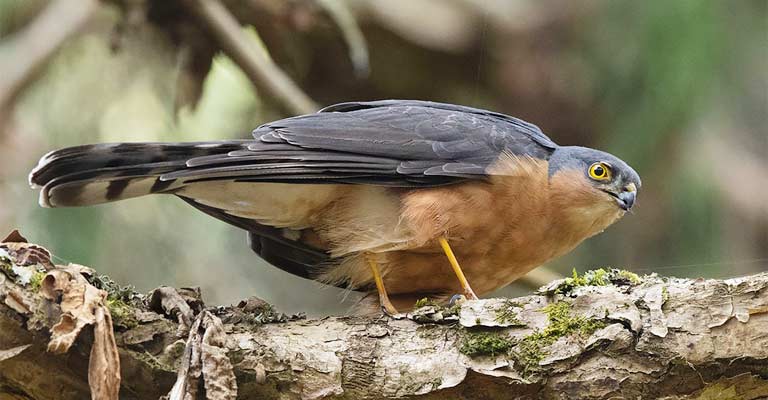
Identifying Characteristics of Rufous-breasted Sparrowhawk
The Rufous-breasted Sparrowhawk (Accipiter rufiventris) is a striking bird of prey found in various regions of sub-Saharan Africa.
Identifying this species requires careful observation of specific characteristics that distinguish it from other birds of prey.
Here are some key points to help in the accurate identification of the Rufous-breasted Sparrowhawk:
Size and Shape
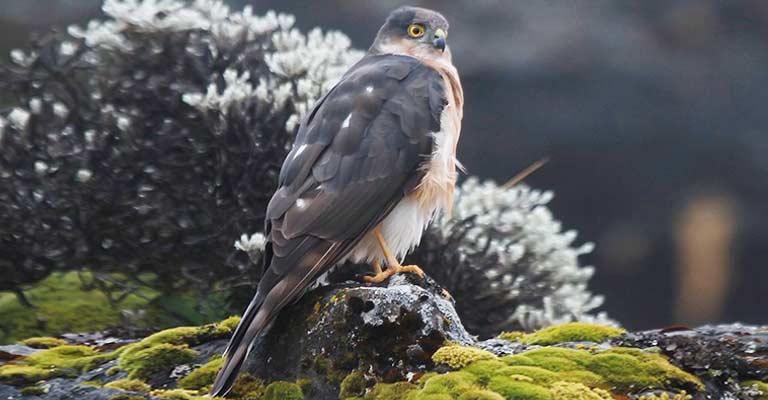
The Rufous-breasted Sparrowhawk is a medium-sized raptor, measuring around 30 to 40 centimeters in length. Its compact and robust build, coupled with short wings and a long tail, gives it a distinctive silhouette in flight.
The wings are broad and rounded, allowing for agile maneuvering through densely vegetated areas.
Coloration
The most prominent feature of this sparrowhawk is its rich rufous or chestnut-colored breast and belly, which serves as a key identification marker.
The upperparts, on the other hand, display a darker, slate-gray or blackish hue. The contrasting colors make the bird easily recognizable, especially when perched or in flight.
Facial Features
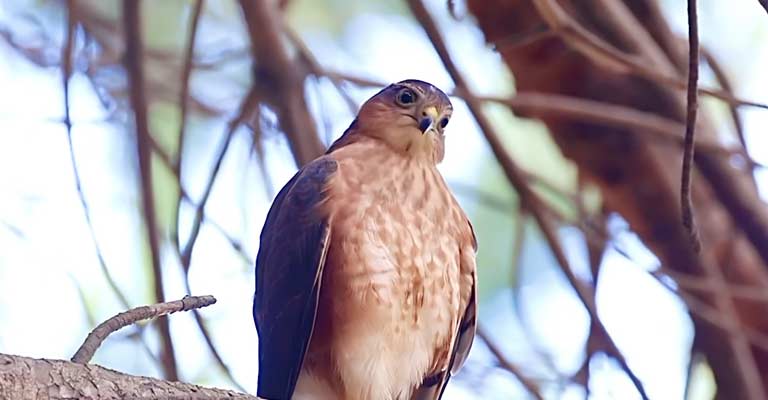
The Rufous-breasted Sparrowhawk exhibits a yellow or yellow-orange cere and legs, adding a splash of color to its appearance.
The facial characteristics include a distinctive white supercilium (eyebrow) and a dark eye stripe. These features contribute to the bird’s expressive and recognizable face.
Tail Bars
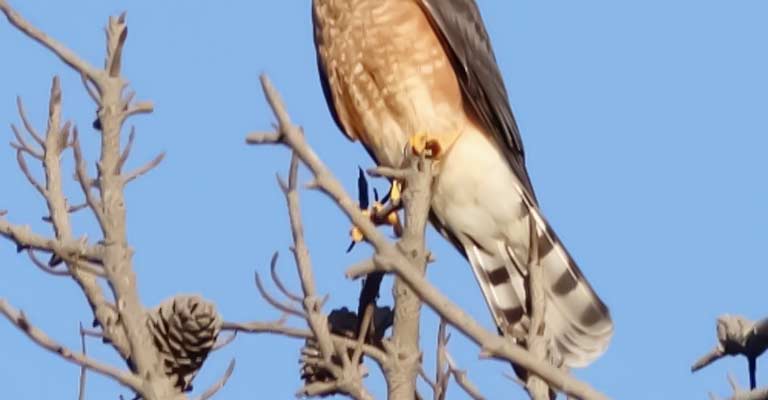
During flight, the tail of the Rufous-breasted Sparrowhawk reveals a series of dark bars.
These bars are prominent against the lighter background of the tail feathers and aid in differentiating it from other similar raptor species.
Habitat Preferences
Observing the bird’s habitat is crucial for identification. The Rufous-breasted Sparrowhawk typically inhabits dense woodlands, forests, and wooded savannahs.
Its preference for such environments, combined with its hunting behavior, distinguishes it from birds of prey adapted to more open habitats.
Flight Pattern
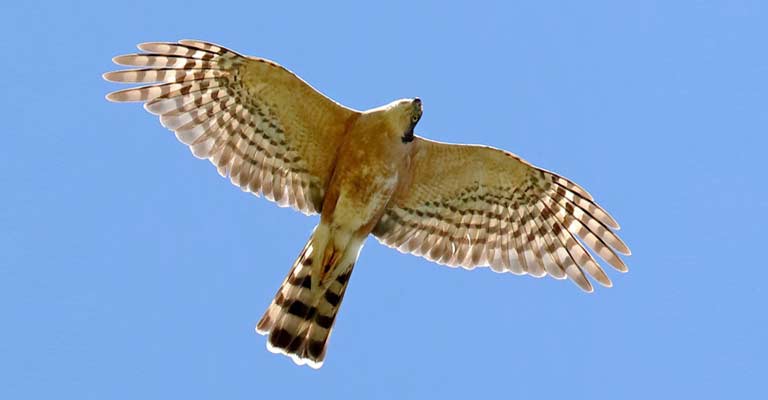
In flight, this sparrowhawk displays a characteristic flap-and-glide pattern.
Its short, rounded wings enable quick and agile movements, making it well-suited for navigating through the intricate vegetation of its preferred habitats.
Vocalizations
Recognizing the vocalizations of the Rufous-breasted Sparrowhawk can aid in identification.
It produces a series of high-pitched, rapid “kleeek” or “kleeek-kleeek” calls, often uttered while perched or during flight.
Familiarizing oneself with these distinct calls enhances the chances of positively identifying the species.
Range and Distribution
Understanding the geographical range of the Rufous-breasted Sparrowhawk is essential.
It is primarily found in sub-Saharan Africa, spanning from Senegal and Gambia in the west to Ethiopia and Somalia in the east, and southwards to South Africa.
Knowledge of its distribution helps eliminate confusion with similar-looking species found in different regions.
Identifying the Rufous-breasted Sparrowhawk involves a holistic approach, considering size, coloration, facial features, flight patterns, vocalizations, and habitat preferences.
A keen eye and familiarity with these distinctive characteristics will contribute to accurate identification and a deeper appreciation of this captivating bird of prey.
Taxonomy of Rufous-breasted Sparrowhawk
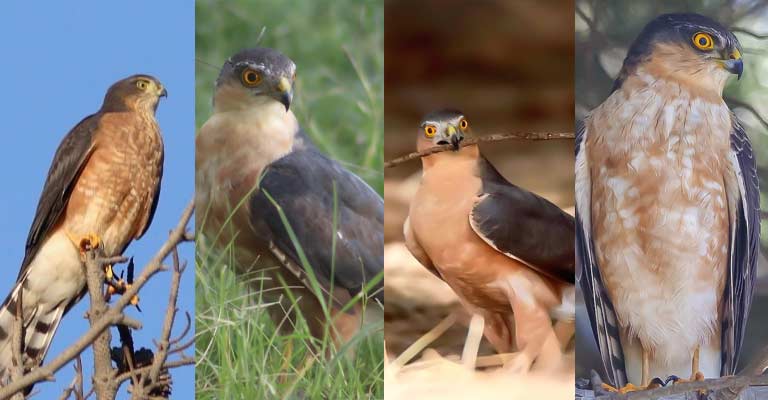
Here is a table outlining the taxonomy details of the Rufous-breasted Sparrowhawk:
| Taxonomic Rank | Classification |
| Domain | Eukaryota |
| Kingdom | Animalia |
| Phylum | Chordata |
| Class | Aves |
| Order | Accipitriformes |
| Family | Accipitridae |
| Genus | Accipiter |
| Species | A. rufiventris |
The Rufous-breasted Sparrowhawk (Accipiter rufiventris) belongs to the family Accipitridae, which includes various birds of prey characterized by strong talons and hooked beaks.
Its taxonomy further classifies it into the order Accipitriformes, along with other diurnal raptors.
The genus Accipiter encompasses small to medium-sized hawks known for their agility in flight and specialized hunting techniques.
Within Accipiter, the species shares its classification with other members, potentially including subspecies or closely related species.
As a distinctive member of its taxonomic group, the Rufous-breasted Sparrowhawk showcases the intricate web of relationships within the avian hierarchy, reflecting both its unique features and shared characteristics with its avian relatives.
Rufous-breasted Sparrowhawk Life History
The Rufous-breasted Sparrowhawk (Accipiter rufiventris) is a fascinating bird of prey with a rich and intricate life history.
From its habitat preferences to nesting behaviors, breeding habits, and conservation status, each aspect contributes to the understanding of this species.
In this exploration of the Rufous-breasted Sparrowhawk’s life history, we delve into its food habits, breeding patterns, potential diseases, treatment options, and the current status of conservation efforts.
Food
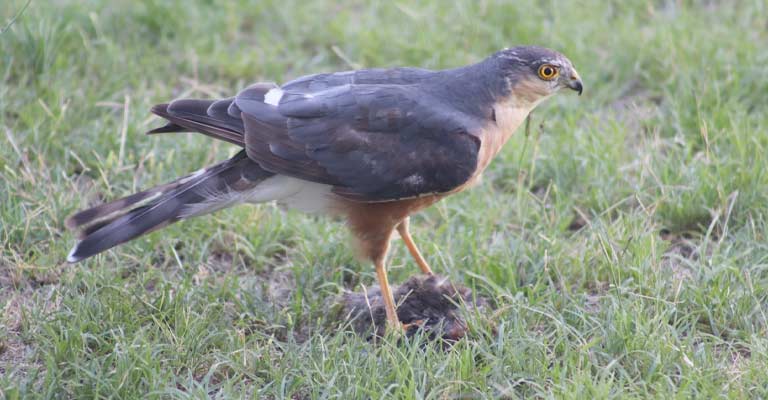
The Rufous-breasted Sparrowhawk is a carnivorous bird, preying primarily on smaller birds and occasionally small mammals.
With its agile flight and sharp talons, it hunts within the dense vegetation of its woodland and forest habitats.
The diet mainly consists of small passerines, such as finches, weavers, and other songbirds.
The sparrowhawk’s ability to navigate through intricate vegetation aids in ambushing its prey, showcasing its adaptability as an effective predator.
Habitat
This species exhibits a preference for wooded environments, including dense woodlands, forests, and wooded savannahs.
The Rufous-breasted Sparrowhawk is well-adapted to maneuvering through these habitats, utilizing its short wings and long tail to navigate with precision.
The choice of such habitats is crucial for successful hunting and nesting, showcasing the bird’s specialization for life within these ecosystems.
Range Map
The Rufous-breasted Sparrowhawk’s distribution spans across sub-Saharan Africa. Its range extends from Senegal and Gambia in the west to Ethiopia and Somalia in the east, and southwards to South Africa.
A range map helps ornithologists and conservationists track and understand the bird’s distribution, aiding in the formulation of targeted conservation strategies.
Nesting
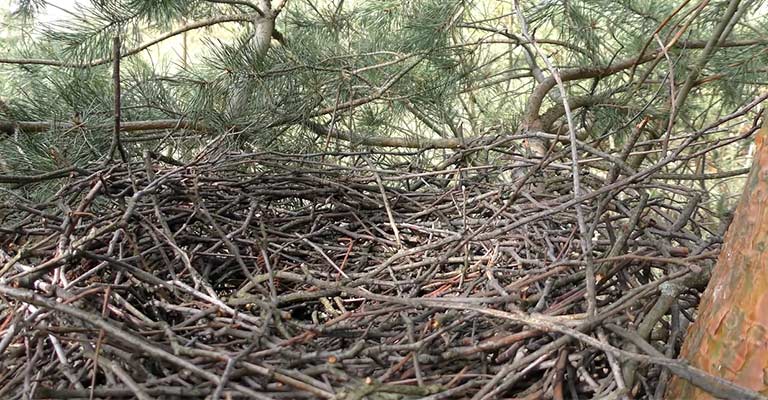
Breeding pairs of Rufous-breasted Sparrowhawks construct nests in the canopy of trees, often hidden from view.
The nests are made of sticks and lined with softer materials, providing a secure environment for the eggs and later, the chicks.
Nesting typically occurs in the breeding season, with the female responsible for incubating the eggs while the male hunts and provides food.
Here’s a table summarizing nesting details of the Rufous-breasted Sparrowhawk (Accipiter rufiventris):
| Nesting Details | Facts |
| Clutch Size | 2 to 4 eggs |
| Number of Broods | Typically 1 per breeding season |
| Egg Length | Approximately 40-50 mm |
| Egg Width | Approximately 32-38 mm |
| Incubation Period | Around 30 days |
| Nestling Period | Approximately 25-30 days |
| Egg Description | Pale bluish-white with occasional spots |
| Nest Type | Platform nest made of sticks |
| Nest Placement | High in the canopy of trees |
| Parental Roles | The female incubates, both parents feed |
| Courtship Displays | Aerial acrobatics and vocalizations |
| Nest Site Selection | Hidden and well-camouflaged in foliage |
| Chick Development | Altricial – born helpless, eyes closed |
| Prey Provisioning | Both parents contribute to feeding |
| Predation Risks | Vulnerable to larger predators |
| Fledgling Independence | Young birds become independent post-fledging |
These nesting details provide insights into the reproductive biology of the Rufous-breasted Sparrowhawk, showcasing its adaptations for successful breeding and raising of offspring within its preferred wooded habitats.
Breeding
The breeding season varies across the species’ range, typically occurring during the warmer months. Courtship displays involve aerial acrobatics and vocalizations, strengthening the pair bond.
After successful mating, the female lays a clutch of eggs, and both parents share responsibilities in rearing the offspring.
The development of the chicks is closely tied to the abundance of prey in the surrounding environment.
Diseases
Like many bird species, the Rufous-breasted Sparrowhawk is susceptible to various diseases. Avian diseases, parasites, and environmental factors can impact the health of individuals and populations.
Monitoring and understanding these health threats are essential for effective conservation measures.
Treatment
In captive populations or instances where intervention is necessary, avian veterinarians and wildlife rehabilitators may provide medical treatment.
Understanding the specific diseases and implementing appropriate care protocols are crucial for the successful rehabilitation and release of affected individuals.
Conservation
While the Rufous-breasted Sparrowhawk is not currently listed as globally threatened, its dependence on wooded habitats makes it susceptible to deforestation and habitat degradation.
Conservation efforts focus on preserving these habitats, ensuring sustainable land use practices, and raising awareness about the importance of maintaining the ecological balance in the regions where the species occurs.
Continued research and monitoring are essential for adapting conservation strategies to address emerging threats and challenges.
The life history of the Rufous-breasted Sparrowhawk reflects its role as a specialized predator within sub-Saharan Africa’s diverse ecosystems.
From its hunting techniques to nesting behaviors and conservation needs, a comprehensive understanding of this species contributes to effective conservation measures and the preservation of its unique place in the avian world.
10 Fun Facts About Rufous-breasted Sparrowhawk
The Rufous-breasted Sparrowhawk (Accipiter rufiventris) is a captivating bird of prey found in sub-Saharan Africa.
Known for its striking appearance and unique behaviors, this species has several interesting quirks that make it a fascinating subject for bird enthusiasts.
Here are 10 fun facts about the Rufous-breasted Sparrowhawk that highlight its distinctive traits and behaviors.
- Dynamic Plumage: The Rufous-breasted Sparrowhawk boasts a striking contrast in its plumage, with a rich chestnut or rufous-colored breast and belly, coupled with dark slate-gray upperparts. This dynamic coloration aids in camouflage within its wooded habitats.
- Agile Hunters: Renowned for their agility, these birds exhibit exceptional flight skills. Their short, rounded wings and long tail allow them to navigate effortlessly through dense vegetation while hunting small birds and mammals.
- Vocal Acrobatics: During courtship displays, the Rufous-breasted Sparrowhawk engages in vocal acrobatics. Their high-pitched, rapid calls, combined with aerial maneuvers, create an impressive spectacle as part of their mating rituals.
- Migratory Patterns: While some individuals are resident throughout the year, others undertake seasonal migrations, showcasing the adaptability of this species to varying environmental conditions.
- Nesting Heights: Nesting high in the canopy of trees, often concealed from view, the Rufous-breasted Sparrowhawk selects hidden locations to protect its eggs and nestlings from potential predators.
- Dietary Preferences: A skilled predator, these sparrowhawks primarily prey on small birds, such as finches and weavers. Their hunting techniques involve ambushing prey within the intricate vegetation of their wooded habitats.
- Parental Cooperation: Both male and female Rufous-breasted Sparrowhawks play active roles in parenting. While the female incubates the eggs, the male contributes to hunting and feeding, highlighting a cooperative parental dynamic.
- Distinctive Tail Bars: In flight, the Rufous-breasted Sparrowhawk displays distinctive dark bars on its tail. This feature aids in quick and accurate identification, especially when observing the bird from a distance.
- Subspecies Variation: The species exhibits subtle variations across its range, leading to the recognition of different subspecies. These variations add to the diversity within the Rufous-breasted Sparrowhawk population.
- Conservation Concerns: Although not currently classified as globally threatened, the Rufous-breasted Sparrowhawk faces habitat-related challenges due to deforestation. Conservation efforts focus on preserving these wooded habitats to ensure the continued well-being of this unique bird.
The Rufous-breasted Sparrowhawk’s charm goes beyond its visual appeal, encompassing its behaviors, adaptations, and contributions to the ecosystems it inhabits.
These fun facts offer a glimpse into the intriguing world of this remarkable bird of prey.
Wrapping Up
The Rufous-breasted Sparrowhawk, with its vibrant plumage and dynamic behaviors, stands as a testament to nature’s marvels.
Its agile flight, cooperative parenting, and unique adaptations for life in wooded habitats underscore the importance of preserving these ecosystems.
Conservation efforts play a pivotal role in ensuring the continued existence of this captivating bird, emphasizing the interconnectedness of all species within our diverse natural world. Thank you very much.